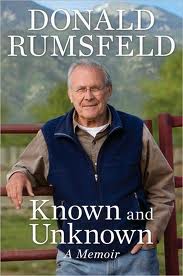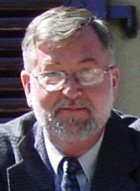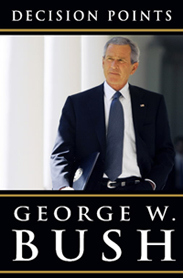Reviews by Dr. John Handley, Vice-President of American Diplomacy Publishers
Decision Points by George W. Bush, New York: Crown Publishers, ISBN 978-0
-307-59061-9, 497 pages, $35.00
Known and Unknown: A Memoir by Donald Rumsfeld, New York: Sentinel (the Penguin Group,) ISBN 978-1-59523-067-6, 815 pages, $36.00
 Depending on one’s political persuasions, many will view both books as apologies, that is, defenses by the authors for what they did or did not do during portions of their respective political careers. Others will view both books as apocryphal—in essence, dubious, spurious, untrue, and erroneous. Personally, I thought both authors presented reasonable and understandable accounts of their decisions and actions, but these two books are decidedly different in tone and scope. Decision Points is largely an account by George Bush to explain what information he had available at the time of the decision and why he made the decisions he made concerning the major crises during his administration including stem cell research, taking the war on terror to the Taliban and Al-Qaeda, the invasion of Iraq, Katrina, the subsequent surge in Iraq, and the financial crisis. Bush addresses his conviction, and that of numerous national security agencies, of Iraqi possession of WMDs and his disappointment when no one found any stockpiles. He does explain the fact that Saddam had used WMD before on Iranians and Kurds and that Saddam had the ability to ramp up chemical and biological agent programs once he felt certain no more UN inspectors would descend upon Iraq. Bush clearly did not ever consider that invading Iraq would divert from American pursuit of OBL and the destruction of al-Qaeda. Concerning the financial crisis, he never doubted the wisdom of massive tax cuts that obviously failed to reduce rising unemployment.
Depending on one’s political persuasions, many will view both books as apologies, that is, defenses by the authors for what they did or did not do during portions of their respective political careers. Others will view both books as apocryphal—in essence, dubious, spurious, untrue, and erroneous. Personally, I thought both authors presented reasonable and understandable accounts of their decisions and actions, but these two books are decidedly different in tone and scope. Decision Points is largely an account by George Bush to explain what information he had available at the time of the decision and why he made the decisions he made concerning the major crises during his administration including stem cell research, taking the war on terror to the Taliban and Al-Qaeda, the invasion of Iraq, Katrina, the subsequent surge in Iraq, and the financial crisis. Bush addresses his conviction, and that of numerous national security agencies, of Iraqi possession of WMDs and his disappointment when no one found any stockpiles. He does explain the fact that Saddam had used WMD before on Iranians and Kurds and that Saddam had the ability to ramp up chemical and biological agent programs once he felt certain no more UN inspectors would descend upon Iraq. Bush clearly did not ever consider that invading Iraq would divert from American pursuit of OBL and the destruction of al-Qaeda. Concerning the financial crisis, he never doubted the wisdom of massive tax cuts that obviously failed to reduce rising unemployment.
The book begins with an interesting chapter on his decision to quit drinking and this single act sets the tone for the book. Whether one shares a personal belief in God or not, it is obvious from this chapter that George Bush is a believer and his faith comes up again and again throughout the book. It is an easy book to read, framed in much the same manner as he speaks, although without any noticeable errors except for his personal habit of using “sure” when “surely” or “certainly” would be grammatically correct.
One interesting factor in the first chapter is the author’s statement that he did make mistakes during his presidency and that he will point out these failings within the subsequent chapters. He does so. These mistakes include personnel decisions; noticeable failures to clarify his remarks, and a tendency to speak before thinking of the various ways his words could and would be taken. He gives several examples of these specific failures. Probable failures include his decisions to keep certain appointees in his administration long after he should have replaced them simply because he did not want to be seen as bending to outside pressures. Some view this trait as loyalty while others see it as merely stubbornness. In addition to these mistakes, Bush comments on actions he wanted to take, such as returning to Washington as soon as possible after the 9/11 attacks, but his security personnel prevented, to getting involved earlier than he did in Katrina, but which state and local leaders thwarted. Rather than comment more on these admitted mistakes, I leave it to you, the reader, to ferret them out for yourself. Although the book contains no footnotes, Bush uses an asterisk after every meeting to list those present at that meeting. Additionally, in the acknowledgements section, Bush lists scores of individuals who helped ensure the accuracy of his recollections, including archivists, personnel involved, and trusted friends.
Known and Unknown by Don Rumsfeld is billed as a memoir but Rumsfeld uses an unusual memoir format void in large part of a chronological presentation. The several pages of introduction to each chapter often touch on events that occurred long after the actual chapter begins. Rumsfeld starts the fourteen part, 50 chapter book with several pages explaining the differences between known knowns (what one knows), known unknowns (known gaps of knowledge), and unknown unknowns (gaps in knowledge one does not know exists), a subject that arose during a 2010 press conference. The author next takes his readers to Baghdad, 20 December 1983, to discuss his visit with Saddam Hussein at the request of President Reagan, who hoped to use Iraq as a counterpoint to Iran and Syria. Rumsfeld agrees with Reagan’s decision stating that Iraq was the lesser of the other two evils at the time. Chapters 1 and 2 (Part I) cover the bombing of the Marine barracks in Lebanon and President Reagan’s eventual decision to withdraw US personnel, a decision Rumsfeld believes sent the wrong message to America’s then and future enemies. The memoir begins in the more chronologically accepted format with Part II, which covers his early years, education, marriage, and service as a U. S. Naval aviator, culminating in his 1962 election to congress at age 30. Part III deals with his “Young Turk” days of congressional activity during the Kennedy and Johnson administrations. Rumsfeld addresses the Nixon years in Part IV, to include his role as head of the Office of Economic Opportunity, as Counselor to the President, and his assignment as Ambassador to NATO, the latter a position he truly wanted and enjoyed. Although Nixon’s presidency ended in embarrassment for him and his administration, Rumsfeld nevertheless displays a certain amount of admiration, perhaps even respect, for the disgraced president. In Part V, Rumsfeld discusses his return to the White House to replace Al Haig as the Chief of Staff, or as Gerald Ford termed the position, as “chief coordinator.” Ford has Rumsfeld’s undying admiration.
Rumsfeld provides insightful comments on all the major players he met during his political life, with large negatives for Nelson Rockefeller and large positives for Gerald Ford and Dick Cheney. He discusses his 1975 confirmation as the nation’s thirteenth and youngest Secretary of Defense and the withdrawal from Vietnam, caused by a Congress that would neither fund the war nor provide funds to assist the South Vietnamese, again sending what he believed to be the wrong message to America’s enemies. Part VII deals with Rumsfeld’s return to civilian life as CEO for the G. D. Searle & Company, a pharmaceutical firm, taking it in eight years to a Fortune 500 organization with an annual profit of over $162 million. In 1982, President Reagan asked Rumsfeld to be his emissary on the UN’s Law of the Sea Treaty to round up support for not signing the treaty because of the seabed mining provisions, and in 1983 President Reagan asked him to be his Special Envoy to the Middle East. In 1986 Rumsfeld briefly considered running in the 1988 presidential campaign, but soon withdrew due to insufficient funds.
The remainder of the book, approximately two-thirds, deals with his service in the Bush administration as U.S. Secretary of Defense, this time as the oldest person appointed to this position. Rumsfeld addresses the decisions he made and why he made them, the recommendations he made about Afghanistan and Iraq and why many were never acted upon or even considered. Rumsfeld considers at least four additional reasons in addition to WMD for removing Saddam as Iraq’s leader and ponders why the Bush administration did not do a better job of convincing the press and the American people that Saddam had to be removed because of these additional reasons. He laments the move by the administration to shift from Saddam’s well-documented crimes to a “freedom agenda” for Iraq and the Middle East. For Rumsfeld, establishing democracy in any Middle East country is not a role for the US military. As far as Rumsfeld is concerned, the US military’s fight in Iraq ended with standing up an Iraqi government and he believes military forces should have been withdrawn at that point. He is not concerned about sectarian strife, stating that the Iraq’s citizens should have sorted their differences out among themselves. He is not a believer in the Powell concept that America had to “fix” Iraq since it purportedly “broke” it. Rumsfeld takes exception to the criticism that he authorized too few troops for the Iraqi mission, stating that he constantly asked the planners and combatant commanders if they needed additional support and everyone agreed, at every phase of the mission, that they had sufficient forces to accomplish the task at hand.
Rumsfeld points out the strengths of the people he admired, the President and Vice-President, the military leaders in Washington and in the theater of operations, and he men and women in military service. He has little good to say about the press or about Congress in general or several well known Members of Congress and Senators in particular. He chastises other national organs, especially the Department of State (DoS), for its inability to live up to its statutory requirements, such as training the Iraqi police force, a failed mission that some two years later DoS transferred to DoD. Colin Powell receives praise while in uniform, but Colin, Condi Rice, and Jerry Bremer all receive considerable condemnation for their actions, or more specifically their inactions, as DoS members. This book reads much like a dissertation since it is heavily footnoted. It appears the author intended to provide a source for just about every comment he made, whether one of fact, of praise, or of condemnation. Like Bush, Rumsfeld had numerous archivists, fact finders, and scores of people read those portions of the book in which they were involved. Although the book may well be completely rejected as a work of fiction by anyone who served or still serves in the DoS, one must admit it is extremely well sourced. ![]()

Dr. John M. Handley, American Diplomacy Publishers Vice-President for Outreach, is a Professor of International Relations for Webster University’s Ft. Bragg campus. A retired US Army Colonel, Dr. Handley spent his Army career in military intelligence, including as a Defense Attaché, the Dean of the School of Attaché Training at the Defense Intelligence College, and Deputy, Resource Management, for the Defense Intelligence Agency.

